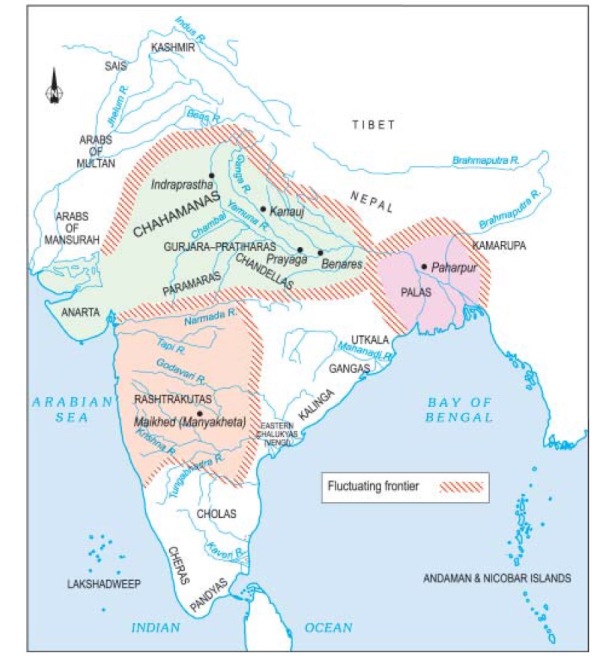Topics
Polity :Major political developmentsin Northern India and the Peninsula,origin and the rise of Rajputs-The Cholas: administration, villageeconomy and society-“Indian Feudalism”-Agrarian economy and urban settle-ments- Trade and commerce- Society: the status of the Brahmanand the new social order-Condition of women-Indian science and technology
Theory
Many new dynasties emerged after the seventh century. Map shows the major ruling dynasties in different parts of the subcontinent between the seventh and twelfth centuries.

The emergence of new dynasties
By the seventh century there were big landlords or warrior chiefs in different regions of the subcontinent. Existing kings often acknowledged them as their subordinates or samantas. They were expected to bring gifts for their kings or overlords, be present at their courts and provide them with military support.
As samantas gained power and wealth, they declared themselves to be maha-samanta, maha- mandaleshvara (the great lord of a “circle” or region) and so on. Sometimes they asserted their independence from their overlords.
One such instance was that of the Rashtrakutas in the Deccan. Initially they were subordinate to the Chalukyas of Karnataka. In the mid-eighth century, Dantidurga, a Rashtrakuta chief, overthrew his Chalukya overlord and performed a ritual called hiranya-garbha (literally, the golden womb). When this ritual was performed with the help of Brahmanas, it was thought to lead to the “rebirth” of the sacrificer as a Kshatriya, even if he was not one by birth.
In other cases, men from enterprising families used their military skills to carve out kingdoms. For instance, the Kadamba Mayurasharman and the Gurjara- Pratihara Harichandra were Brahmanas who gave up their traditional professions and took to arms, successfully establishing kingdoms in Karnataka and Rajasthan respectively.
Administration in the kingdoms
Many of these new kings adopted high-sounding titles such as maharaja-adhiraja (great king, overlord of kings), tribhuvana-chakravartin (lord of the three worlds) and so on. However, in spite of such claims, they often shared power with their samantas as well as with associations of peasants, traders and Brahmanas.
In each of these states, resources were obtained from the producers, that is, peasants, cattle-keepers, artisans, who were often persuaded or compelled to surrender part of what they produced. Sometimes these were claimed as “rent” due to a lord who asserted that he owned the land. Revenue was also collected from traders.
Four hundred taxes! The inscriptions of the Cholas who ruled in Tamil Nadu refer to more than 400 terms for different kinds of taxes. The most frequently mentioned tax is vetti, taken not in cash but in the form of forced labour, and kadamai, or land revenue. There were also taxes on thatching the house, the use of a ladder to climb palm trees, a cess on succession to family property, etc.
These resources were used to finance the king’s establishment, as well as for the construction of temples and forts. They were also used to fight wars, which were in turn expected to lead to the acquisition of wealth in the form of plunder, and access to land as well as trade routes.
The functionaries for collecting revenue were generally recruited from influential families, and positions were often hereditary. This was true about the army as well. In many cases, close relatives of the king held these positions.
Prashastis and land grants
Prashastis contain details that may not be literally true. But they tell us how rulers wanted to depict themselves – as valiant, victorious warriors. They were composed by learned Brahmanas, who occasionally helped in the administration. Kings often rewarded Brahmanas by grants of land.
Unusual for the twelfth century was a long Sanskrit poem containing the history of kings who ruled over Kashmir. It was composed by an author named Kalhana. He used a variety of sources, including inscriptions, documents, eyewitness accounts and earlier histories, to write his account. Unlike the writers of prashastis, he was often critical about rulers and their policies.
Warfare for wealth
Each of these ruling dynasties was based in a specific region. At the same time, they tried to control other areas. One particularly prized area was the city of Kanauj in the Ganga valley.
For centuries, rulers belonging to the Gurjara-Pratihara, Rashtrakuta and Pala dynasties fought for control over Kanauj. Because there were three “parties” in this long- drawn conflict, historians often describe it as the “tripartite struggle”.
Rulers also tried to demonstrate their power and resources by building large temples. So, when they attacked one another’s kingdoms, they often chose to target temples, which were sometimes extremely rich.
One of the best known of such rulers is Sultan Mahmud of Ghazni, Afghanistan. He ruled from 997 to 1030, and extended control over parts of Central Asia, Iran and the north-western part of the subcontinent. He raided the subcontinent almost every year – his targets were wealthy temples, including that of Somnath, Gujarat. Much of the wealth Mahmud carried away was used to create a splendid capital city at Ghazni. He was interested in finding out more about the people he conquered, and entrusted a scholar named al-Biruni to write an account of the subcontinent. This Arabic work, known as the Kitab-al Hind, remains an important source for historians. He consulted Sanskrit scholars to prepare this account.
Other kings who engaged in warfare include the Chahamanas, later known as the Chauhans, who ruled over the region around Delhi and Ajmer. They attempted to expand their control to the west and the east, where they were opposed by the Chalukyas of Gujarat and the Gahadavalas of western Uttar Pradesh. The best-known Chahamana ruler was Prithviraja III (1168-1192), who defeated an Afghan ruler named Sultan Muhammad Ghori in 1191, but lost to him the very next year, in 1192.
A closer look–The Cholas
From Uraiyur to Thanjavur : How did the Cholas rise to power?
A minor chiefly family known as the Muttaraiyar held power in the Kaveri delta. They were subordinate to the Pallava kings of Kanchipuram. Vijayalaya, who belonged to the ancient chiefly family of the Cholas from Uraiyur, captured the delta from the Muttaraiyar in the middle of the ninth century. He built the town of Thanjavur and a temple for goddess Nishumbhasudini there.

The successors of Vijayalaya conquered neighbouring regions and the kingdom grew in size and power. The Pandyan and the Pallava territories to the south and north were made part of this kingdom.
Rajaraja I, considered the most powerful Chola ruler, became king in 985 and expanded control over most of these areas. He also reorganised the administration of the empire.
Rajaraja’s son Rajendra I continued his policies and even raided the Ganga valley, Sri Lanka and countries of Southeast Asia, developing a navy for these expeditions.
Splendid temples and bronze sculpture
The big temples of Thanjavur and Gangaikonda- cholapuram, built by Rajaraja and Rajendra, are architectural and sculptural marvels. Chola temples often became the nuclei of settlements which grew around them. These were centres of craft production. Temples were also endowed with land by rulers as well as by others. The produce of this land went to maintain all the specialists who worked at the temple and very often lived near it – priests, garland makers, cooks, sweepers, musicians, dancers, etc. In other words, temples were not only places of worship; they were the hub of economic, social and cultural life as well.
Amongst the crafts associated with temples, the making of bronze images was the most distinctive. Chola bronze images are considered amongst the finest in the world. While most images were of deities, sometimes images were made of devotees as well.
Agriculture and irrigation
Many of the achievements of the Cholas were made possible through new developments in agriculture. The river Kaveri branches off into several small channels before emptying into the Bay of Bengal. These channels overflow frequently, depositing fertile soil on their banks. Water from the channels also provides the necessary moisture for agriculture, particularly the cultivation of rice. Although agriculture had developed earlier in other parts of Tamil Nadu, it was only from the fifth or sixth century that this area was opened up for large-scale cultivation. Forests had to be cleared in some regions; land had to be levelled in other areas. In the delta region embankments had to be built to prevent flooding and canals had to be constructed to carry water to the fields. In many areas two crops were grown in a year.

A ninth century sluice- gate in Tamil Nadu. It regulated the outflow of water from a tank into the channels that irrigated the fields.
In many cases it was necessary to water crops artificially. A variety of methods were used for irrigation. In some areas wells were dug. In other places huge tanks were constructed to collect rainwater. Remember that irrigation works require planning – organising labour and resources, maintaining these works and deciding on how water is to be shared. Most of the new rulers, as well as people living in villages, took an active interest in these activities.
The administration of the empire : How was the administration organised?
Settlements of peasants, known as ur, became prosperous with the spread of irrigation agriculture. Groups of such villages formed larger units called nadu. The village council and the nadu had several administrative functions including dispensing justice and collecting taxes. Rich peasants of the Vellala caste exercised considerable control over the affairs of the nadu under the supervision of the central Chola government.
The Chola kings gave some rich landowners titles like muvendavelan (a velan or peasant serving three kings), araiyar (chief), etc. as markers of respect, and entrusted them with important offices of the state at the centre. We have seen that Brahmanas often received land grants or brahmadeya. As a result, a large number of Brahmana settlements emerged in the Kaveri valley as in other parts of south India. Each brahmadeya was looked after by an assembly or sabha of prominent Brahmana landholders. These assemblies worked very efficiently. Their decisions were recorded in detail in inscriptions, often on the stone walls of temples.
Associations of traders known as nagarams also occasionally performed administrative functions in towns. Inscriptions from Uttaramerur in Chingleput district, Tamil Nadu, provide details of the way in which the sabha was organised. The sabha had separate committees to look after irrigation works, gardens, temples, etc. Names of those eligible to be members of these committees were written on small tickets of palm leaf and kept in an earthenware pot, from which a young boy was asked to pick the tickets, one by one for each committee.









